This week’s Sole Survivor focuses on the class the world’s most famous steam locomotive belongs to, the London and North Eastern Railway (LNER) Gresley A1 and A3 Class which the “Flying Scotsman” is a member of. After looking at the background of both classes, we will then look at the preservation history of No.4472/60103 “Flying Scotsman”.
History of LNER Gresley A1 and A3 Class
Gresley designed and built the first two members of the A1 Class while Chief Mechanical Engineer (CME) of the Great Northern Railway (GNR).
The A1s featured a 4-6-2 ‘Pacific’ wheel arrangement, the first class with this wheel arrangement on the GNR.
The Ivatt ‘Atlantics’, 4-4-2 wheel arrangement, had been the largest express passenger engines on the GNR, with the A1s built as replacements as the heavier loads were pushing the Ivatt Atlantics to their limits.
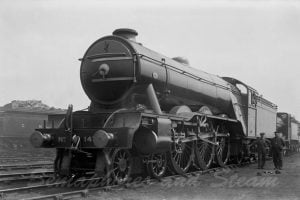
The biggest benefit for using the Pacific wheel arrangement was it allowed bigger boilers to be fitted to the A1s, increasing their steam capacity which enabled them to haul heavier trains for longer distances compared to the Atlantics. The basic dimensions and features include: 4-6-2 ‘pacific’ wheel arrangement (coupled wheels – 6 foot (ft) 8 inch (in), leading truck – 3ft 2in and trailing – 3ft 8in), boiler pressed at 180 lbf/in2, three cylinders (two outside cylinders and one inside (20 in diameter and 26 in stroke) worked by Walschaerts valve gearing (for outside cylinders, inside cylinder worked by Gresley conjugated), 70ft and 5in in length, total weight came in at 91.35 long tons (locomotive only) and a tractive effort of 29,835 lbf.
The formation of the LNER also brought another design of Pacific onto the stock list, the Raven Pacific. These had been designed and built by Raven as CME of the Great Eastern Railway (GER). Both types were tested against each other, and although the Ravan Pacifics maintaining steam pressure more consistently, the A1s consumed significantly less coal and water. This combined with the overall design of the A1s being declared as suitable for further developments, the A1s were chosen as the standard design for Pacific engines.
Production series
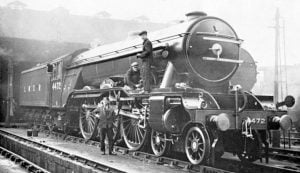
Under the GNR, a batch 10 engines were ordered, to be built at Doncaster Works known as ‘The Plant’. The first member of this batch, No.4472 “Flying Scotsman”, was completed under LNER. This batch was completed by September 1923.
Further batches were ordered and completed by both The Plant and North British Locomotive Company, with the final locomotive of the A1 class being completed in December 1924, this being No.2743 (60089) “Felstead”.
A1s Performance in Service
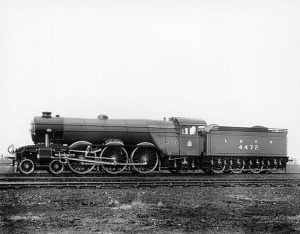
The new Pacifics soon proved they were more than capable at hauling the heavy express trains. When brought under LNER ownership, the class had to be shortened in height to allow them to run over tracks now owned by the LNER, but previously owned by other pre-grouping companies which had smaller loading gauges. When larger tenders with corridors built in were fitted to the class, they could haul the non-stop trains between London King’s Cross station and Edinburgh Waverley station.
This service was called the Flying Scotsman, which the engine No.4472 “Flying Scotsman” was named after. The A1s would also haul other express trains, such as trains from King’s Cross to Peterborough.
Issues and Improvements
Gresley’s Valve Gearing arrangement caused the A1s some issues, such as high water and coal consumption. This was highlighted in the 1925 Exchange Trials when the A1s were tested against the Great Western Railway 4073 ‘Castle’ Class. After the trials, modifications were made which greatly improves consumption of both water and coal. This was another factor which allowed them to haul the non-stop Flying Scotsman train service, as they now consumed less coal than the tender’s capacity.
Others improvements included fitting Knorr type piston valves over the piston valve rings originally fitted. This lead to less factional heat loss.
The A3 Class
Many modifications were tried and tested on the A1s which lead to the development of the A3 class. The main difference between the two classes was the boiler pressure, 180psi for the A1s, 220psi for the A3s. This lead to an increase in tractive effort from 29,835 lbf to 36,465 lbf (When both classes had 20in by 26in cylinders). The A3s also had an increased Superheated surface as more flues were added. This went from 525 sq ft in the A1s to 1,104 sq ft in the A3s.
1927 saw the first two engines rebuilt with the new boilers. Gresley conducted some tests between the A1s and A3s, which showed that the improvements were successful. In time the rest of the A1s were rebuilt as A3s, but this wasn’t completed until 1947.
A3s Performance in Service
The new A3 locomotives were allocated the same very capable engines. Members of the class had been known to achieve 100mph and over on the East Coast Mainline, where the class hauled the top express trains until the introduction of the A4s. The A3s could be seen across the whole LNER network, from the Great Central Mainline to express trains in Scotland. The class could also occasionally been seen on freight trains, especially during War World 2.
All 79 of the A1s and A3s survived into British Rail days. The A3 class continued to be developed after Nationalisation in 1948. The final A3s were converted to left-hand drive by 1954.
Like the A1s, A3s were fitted with corridor tenders, which had the same improvements as the A1s (such as the not having to stop for a crew change). Unfortunately, these were taken off when the A4s were introduced.
Issues and Improvements
In this section, we will look into the issues surrounding the A1s/A3s and how, if any, improvements were made.
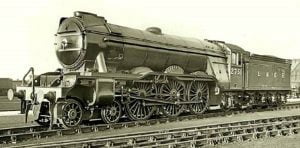
Drifting smoke from the double blast pipe and chimney was an issue with the A3s. Various smoke deflecting measure had been tested on No.2751 “Humorist”. Whilst under LNER ownership, most of the class were fitted with single chimneys. Short smoke deflectors at the base of the double chimney on 2751 “Humorist”, which proved satisfactory in service. Eventually, large smoke deflectors, the same type as the ones fitted by Thompson to his design on Pacifics. In the late 1950s, the class was fitted with double Kylchap blast pipe and chimney, and with this, the German type of smoke deflector was recommended to reduce smoke drift. These proved successful and was fitted to the whole class bar 2751 “Humorist”.
A4 boilers were fitted to some of the A3s from 1954. This wasn’t an improvement in performance, but simply because A3 spares were then in short supplies. The boilers were in an unstreamlined form and had their pressures reduced to 220psi.
Decline and Withdrawal
The improvements on the A3s worked very well, but unfortunately, the BR Modernisation Programme was well into the advanced stage.
The first A3 was withdrawn in 1959, with Deltics replacing the A3s on the East Coast Mainline in 1961. The A3s, therefore, changed roles. Most notably, they have seen hauling expresses to Scotland on the Midland route out of Leeds station.
The last A3 to be scrapped was No.60052 Prince Palatine, which was withdrawn from traffic in January 1966.
The only A3 not to be scrapped was 4472 Flying Scotsman. This locomotive had its final run on the 14th January 1963 and was withdrawn in the same year, but, as we will see in the next section, this wasnt the end of this famous locomotive.
Preservation
In this section, we will cover the preservation era of the world-famous Flying Scotsman, through its various owners and how it is has got to where it is today.
When British Railways announced it was going to scrap Flying Scotsman, a group was set up with a proposed aim to save the loco. Unfortunately, ‘Save Our Scotsman’ was unable to raise the £3,000 to buy the locomotive from British Railways.
Alan Pegler
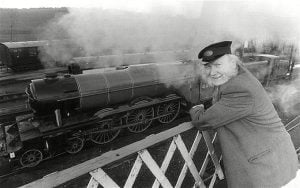
In 1961, Alan Pegler received £70,000 for his shares in Northern Rubber when it was sold to Pegler’s Valves (a company started by Alan Pegler’s Grandfather). When Flying Scotsman came up for scrap, Mr Pegler, along with support from the then Prime Minister, Harold Wilson, bought Flying Scotsman outright from British Railways.
Once Mr Pegler had bought 4472, he spent a large amount of money on overhauled and restored at Doncaster Works. The restoration was made to be as close as possible to its LNER condition, this included having the smoke deflectors removed and having the double chimney replaced with a single variant. The tender for the locomotive was also replaced by one with a corridor, in which the locomotive had between 1928 and 1936. Finally, Alan Pegler had Flying Scotsman painted into LNER Apple Green livery.
Alan Pegler then managed to persuade the board at British Railways to let him run specials on the mainline. At the time, this was the only steam locomotive running on the mainline. The locomotive worked a number of tours, including a non-stop tour from London to Edinburgh, in 1968, the same year in which steam locomotives officially ended on British Rail, because of this, servicing points for steam locomotives, such as water towers, were also depleting, so in 1966, Alan Pegler purchased a second corridor tender and had this adapted into a water tank and this was coupled behind the normal tender.
Flying Scotsman and Alan Pegler had a contract which permitted him to run Flying Scotsman on British Railways until 1972, after an overhaul in 1968/69, the UK Government agreed to support the running of the locomotive in United States of America and Canada, the idea was to support British Exports. To make sure Flying Scotsman was legal to run in the USA, a cowcatcher, bell, buckeye coupling, American whistle, air brakes and hi-intensity lamp were all fitted to the locomotive before heading out over the pond.
Unfortunately, the tour ran into problems upon starting from Boston, some states saw the locomotive as a fire hazard and had increasing costs for the locomotive because of a diesel locomotive having to head its train. However, the locomotive still hauled trains from Boston to New York and Dallas in 1969. The train also ran from Texas to Wisconsin and Montreal in 1970. In 1971, Flying Scotsman ran from Toronto to San Francisco. In total, Flying Scotsman ran for a total of 15,400 miles on its USA tour.
It later went from bad to worse for Flying Scotsman and Alan Pegler, Government support of the tour was stopped by Edward Heath, the then Prime Minister, in 1970. Alan Pegler then chose to still run for the 1970 season, but by the end of the tour, the money was gone and Alan Pegler was in debt of £132,000.
Alan Pegler then came home to the UK in 1971 and was declared bankrupt by the High Court in the UK in 1972.
William McAlpine
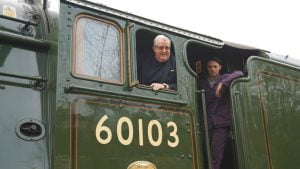
After Alan Pegler was made bankrupt in 1972, speculation started to arise for Flying Scotsman’s future, will it remain in the USA? Will it be broken up? These were some of the questions being asked. After a phone call in 1973 with Alan Bloom, William McAlpine bought the locomotive for £25,000 from the finance company at San Francisco docks. Flying Scotsman finally returned to the UK via the Panama Canal in February 1973 and went to Derby Works to be restored.
After restoration, trial runs took place at the Paignton and Dartmouth Steam railway in 1973, after which, the locomotive was transferred to Carnforth Steamtown where it worked a variety of steam railtours. In 1977, Flying Scotsman went to Vickers Engineering Works for heavy repairs and an unused replacement boiler being fitted.
After its repairs, Flying Scotsman left the UK once again, this time, it was destined for Australia and their bicentenary celebrations at the Aus Steam Festival 1988. Flying Scotsman arrived in October 1988. The event organisers originally wanted 4468 Mallard to visit Australia but were unavailable due to the 50th anniversary of its world record run. During the next year, Flying Scotsman covered more than 28,000 miles on Australian track, which included a run from Sydney to Perth via Alice Springs, where it became the first steam locomotive to travel on the then recently built Central Australian Railway. Other highlights included a double-headed run with NSW No.3801. In its visit to Perth, it was reunited with GWR 4073 Class Pendennis Castle.
Another record for Flying Scotsman came on a tour to Alice Springs from Melbourne where Flying Scotsman travelled 422 miles from Parkes to Broken Hill non stop, the longest run by a steam locomotive ever recorded. Another record was set when the locomotive took a 735-tonne train over the 490 mile stretch from Tarcoola and Alice Springs.
After its run in Australia, Flying Scotsman returned to the UK in 1990 and worked on the mainline hauling tours until its mainline certificate expired in 1993. After this, 4472 then visited various heritage railways in order to raise funds for its upcoming overhaul which included refitting German-style smoke deflectors and a double chimney. By 1995, Flying Scotsman was in bits at Southall in West London and owned by William McAlpine and Pete Waterman.
Tony Marchington
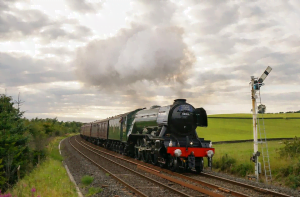
Flying Scotsman was once again facing an uncertain future, this time owing to the cost of restoration and cost of equipment for mainline running. Dr Tony Machington saved the locomotive again in 1996 and had her overhauled at a cost of £1 million, the most extensive overhaul of the locomotives life at the time.
Flying Scotsman returned to steam and saw regular use on the VSOE Pullman and other tours on the mainline. In 2002, Tony Marchington proposed a new business plan which included the making of a Flying Scotsman Village in Edinburgh. Unfortunately, in 2003, Edinburgh City Council turned down the plans and in the same year, Tony Marchington was declared bankrupt, making him the second owner to be declared bankrupt after Alan Pegler.
National Railway Museum
In 2004, a debt agency acting for Flying Scotsman PLC (the company which Tony Marchington set up for the Flying Scotsman Village) announced it would hold a bid auction for the locomotive, which was going to be held on the 2 April 2004.
Fearing the locomotive would be sold to a foreign owner, the National Railway Museum in York announced it would be bidding for the locomotive and started an appeal for funds. They had a successful bid of £2.3 million for the locomotive. The money of which came from a £1.8m grant from the National Heritage Memorial Fund, the remainder coming from £350,000 in donations, which was matched by Richard Branson, and £70,000 coming from the Yorkshire Post. Included in the sale of the locomotive was the A3 pattern spare boiler which Flying Scotsman had carried from 1965 to 1978, spare cylinders and a Mk1 support coach. The locomotive arrived in York to celebrate Railfest 2004, a celebration of 200 years of rail travel.
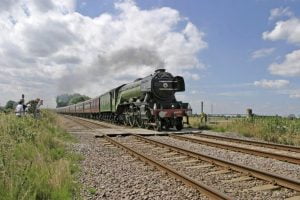
The National Railway Museum was then under pressure from the donors who helped the NRM to buy locomotive. They subsequently decided to run her on the mainline on charter trains out of York as well as on the Scarborough Spa Express from York to Scarborough, although it became apparent that Flying Scotsman had a few problems. Its condition became apparent very quickly after. It was pulled from service in September 2004 and was sent for heavy intermediate repairs, which was completed in May 2005, the hope being that this would help reliability.
In January 2006, Flying Scotsman entered the National Railway Museum workshop for its major overhaul, expected to cost around £750,000, the overhaul would see the locomotive return to Gresley’s original specification. The locomotive was placed in the bay so the overhaul was viewable to the visiting public.
In June 2005, the spare A3 boiler was sent to Riley & Son (E) Ltd to be rebuilt. It was decided to use this because of the desire to restore Flying Scotsman to its original condition, and because it was deemed that the A4 boiler was in such a bad state because of the up-rating of the boiler to 250psi during the last private overhaul, the A4 boiler was sold to Jeremy Hosking for use on his LNER A4 4464 Bittern.
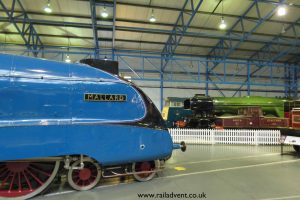
July 2007 came, and the Museum decided to push back the completion date by 18 months due to issues with the boiler restoration. In January 2009, the Museum launched its SOS (Save Our Scotsman) appeal, hoping to raise £250,000 for the locomotive due to misaligned frames and the right-hand cylinder being cracked. The hope was to have the work done by 2010.
Unfortunately, in June 2011, cracks were found in the horn blocks which led to testing which in turn found various latent cracks throughout the frame assembly leading to the replacement of the main stretcher bar, horn ties and middle cylinder motion bracket, all were deemed beyond repair.
In October 2012, the NRM produced a report into why there was a delay and additional costs in the overhaul of the locomotive. It found that the museum had massively underestimated the task in hand. It also found that management lacked experience or resources to complete the task, which was also hampered by illness.
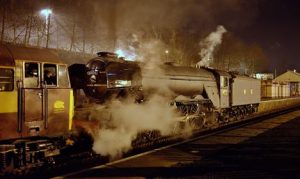
Following on from the report, the National Railway Museum commissioned First Class Partnerships, or FCP for short, to review the remaining work. The NRM was hit with a blow in 2013 from the FCP when they announced that they have determined that the locomotive would not return to the mainline until at least 2015, and they believed that the outstanding work should be outsourced to another company. In October 2013, the NRM announced that Riley & Son was to complete the work on 4472. In April 2015, the boiler for Flying Scotsman left the NRM for Riley & Sons workshop to be reunited with the rest of the locomotive.
Return To Steam
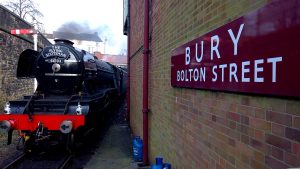
Flying Scotsman returned to service in January 2016 where it began running in at the East Lancashire Railway. The locomotive ran in LNER Wartime Black livery with Wartime numbers, 103 and 502, on the cab sides.
Faulty brakes meant that Flying Scotsman couldn’t haul its inaugural train on the 23rd January. However, repairs were completed in time for Flying Scotsman to return to the mainline on the Cumbrian Mountain Express from Carnforth to Carlisle on the 6th February. It was then painted into BR Brunswick Green and ran its inaugural train from London Kings Cross to York on the 25th February.
Late in 2016, the National Railway Museum announced that the locomotives overhaul cost a total of £4.5 million.
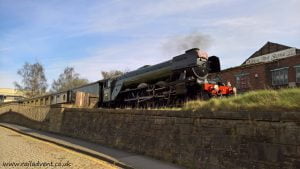
Ever since returning to the mainline in 2016, Flying Scotsman has drawn in the crowds everywhere it goes, whether it be on the mainline, or whilst visiting one of the various heritage railways around the UK, including the Bluebell Railway, Keighley & Worth Valley Railway and the North Yorkshire Moors Railway.
We hope you enjoyed this week’s Sole Survivor, it certainly was a long one! The next instalment will be published two weeks from now (Friday 29th of June), with next Friday seeing the next “Class Information” being released.
- Visit the RailAdvent news homepage
For the latest railway news - Visit the RailAdvent Shop
For railway related goodies! - Visit LocoStop – Our New Social Network
Come and share your photo’s and video’s, join the discussion.
Find out what others are sharing

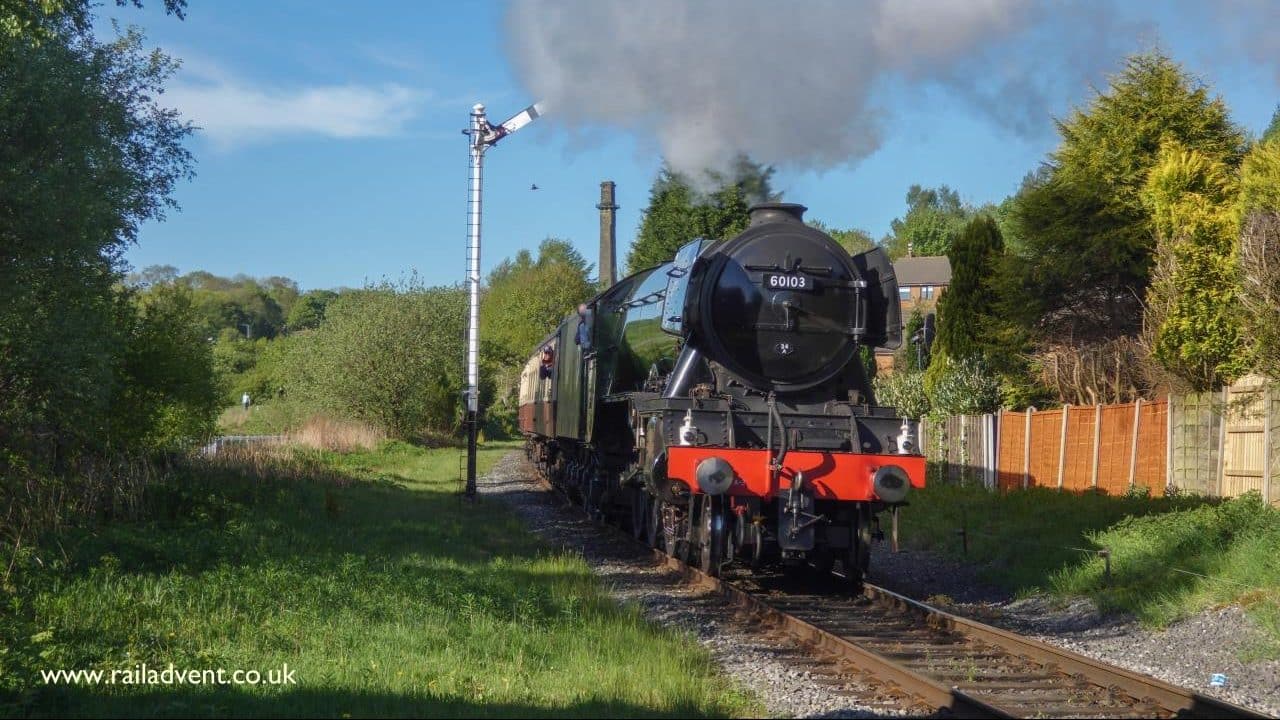



Responses
[…] Learn more about 60103 Flying Scotsman in our Sole Survivor by clicking here […]